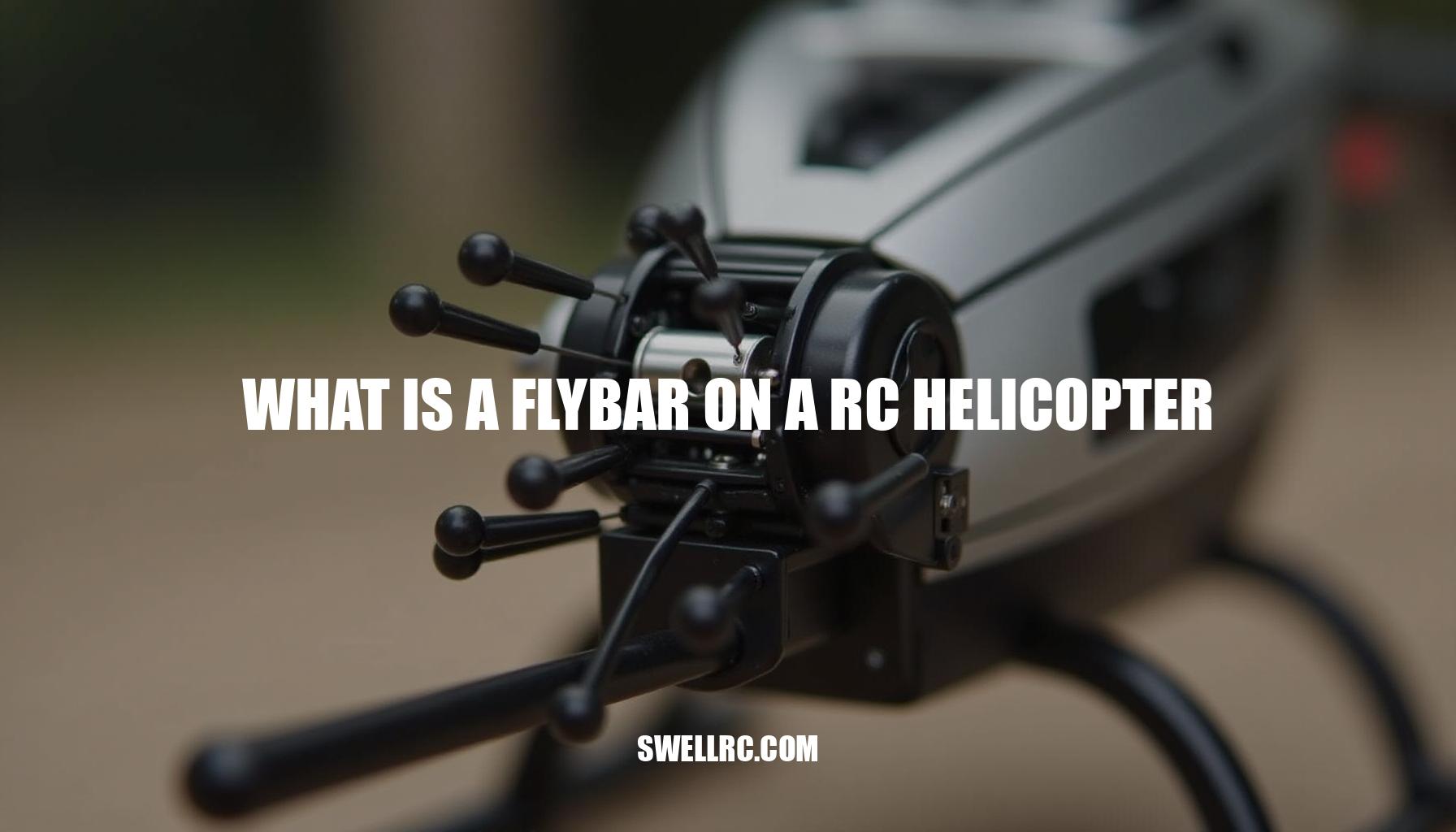What Is A Flybar On A RC Helicopter? Explained
I still remember the exact moment everything clicked—the point when I finally understood why one RC helicopter tracked smoothly like it was on invisible rails, while another felt twitchy and unpredictable in my hands. After hours of experimenting with different rotor head designs and countless flights, I discovered that the secret lay in the flybar system. This seemingly simple mechanical marvel changed the entire game of RC helicopter control system and stability for me.
If you’re an RC pilot, you’ve probably wrestled with the age-old mystery of flybar vs flybarless helicopters—wondering what that weighted bar perched above the main rotor really does. For the uninitiated, a flybar is a small, weighted stabilizer bar that mechanically smooths out pilot inputs and counters disturbances, effectively acting as the helicopter’s natural balancing force. Iconic models like the scale-favorite RC Bell 47 showcase this classic flybarred rotor head design in action, offering pilots that dependable in-flight forgiveness.
Join me on this flight of discovery, where by the end, you’ll not only grasp exactly what a flybar is and how it works, but also understand its pivotal role in shaping RC helicopter history and how it stacks up against the sleek controls of modern flybarless systems. Whether you’re passionate about remote control flight or fine-tuning your RC helicopter stability, this guide will provide the clarity you need to elevate your piloting skills.
Section One – “Understanding the Flybar: The Mechanical Brain of Early RC Helicopters”
Curious about what is a flybar on a RC helicopter? Imagine it as a smart little lateral bar mounted atop the rotor head, equipped with paddles or weights at each end. This clever device functions as a mechanical gyroscope, which is key to pioneering mechanical stabilization in RC helicopters long before electronic gyros became popular.
The flybar’s primary role is to govern rotor blade pitch control and enhance RC helicopter stability by interacting with the swashplate system through the mixing arms.
The magic lies in the gyroscopic effect in RC helicopters. As the helicopter nears imbalance, the spinning flybar resists sudden changes in its plane of rotation, thanks to gyroscopic inertia. Due to phase lag (precession), this resistance translates into subtle corrective inputs on the main blades’ pitch, effectively damping overcontrol and keeping the aircraft steady.
To visualize this, think of a tightrope walker’s pole or balancing a broomstick on your palm—the extra moment and inertia give you crucial leverage and time to react, stabilizing the system against disturbances.
| Component | Function |
|---|---|
| Transmitter Input | User commands for direction and throttle |
| Servos | Convert commands into mechanical movement |
| Swashplate | Transfers servo motions to rotor blades |
| Mixing Arms | Links the swashplate to flybar seesaw and blade grips |
| Flybar Seesaw | Acts as a dynamic stabilizer and intermediary |
| Main Blade Grips | Adjust blade pitch based on combined inputs |
A simple textual diagram helps here:
- Top View of Rotor Head: [Flybar with paddles] — [Seesaw hub] — [Mixing arms to blade grips]
- Side View: [Swashplate] → [Flybar cage] → [Main grips]
The paddles on the flybar act like miniature aerodynamic “reference wings,” biasing the rotor head toward level flight and continually compensating for external forces—it’s an elegant physical feedback loop built right into the mechanics.
Before electronic gyros revolutionized stability control, flybars were the foundational technology making agile yet stable helicopter flight possible. For those interested in how modern systems compare, electronic gyros used in RC planes offer similar stabilization functions but rely on sensors and processors rather than mechanical inertia—read more about that in this RC plane gyro overview.
Here’s a fun experiment to feel the flybar’s influence firsthand: try shifting flybar weights outward to increase rotational inertia, which slows the helicopter’s response but makes it notably more stable. Conversely, moving the weights inward reduces inertia, making the heli more agile yet twitchier. Adjusting paddle pitch tweaks the damping effect and flip rate, giving you a hands-on appreciation of this ingenious mechanical stabilizer.
Understanding what is a flybar on a RC helicopter shines a spotlight on how mechanical stabilization, gyroscopic effects, and the swashplate system harmonize to make those tiny rotor blades perform wonders of control and balance in the skies.
Section Two – “From Flybars to Flybarless: How Technology Took Over Stability”
RC helicopter technology has seen a significant evolution with the advent of flybarless helicopter systems, shifting from the traditional mechanical stabilization methods to advanced electronic controls. Classic models like the Double Horse 9101 feature a flybar system that relies on mechanical inertia and paddle aerodynamics to stabilize rotor dynamics. Meanwhile, modern flybarless systems, such as installed in the ESKY 150 V3, employ sensors like MEMS gyros and accelerometers combined with sophisticated software to manage rotor head behavior in real time.
My personal flight tests vividly highlight the differences: hovering a flybarred heli feels like controlling a pendulum — there’s a natural “pendulum calm” due to the physical flybar dampening corrections. On the other hand, the flybarless’s response is much sharper and more “locked-in,” providing precise attitude holding and quick reactions, especially during agile 3D maneuvers or in gusty wind conditions. Integrating FPV (first person view) setups, as discussed in FPV RC Helicopter systems, further amplifies the need for responsive and reliable stabilization that flybarless units excel at.
Below is a comprehensive comparison table highlighting the core differences in RC helicopter control system design philosophies, emphasizing rotor head design and software stabilization aspects:
| Feature | Flybar System | Flybarless System |
|---|---|---|
| Stabilization method | Mechanical inertia and paddle aerodynamics | Electronic sensors (3-axis or 6-axis) with control algorithms |
| Setup complexity | More linkages to level and balance; paddle pitch and weights to tune | Fewer mechanical parts; requires software setup and electronic tuning |
| Maintenance | More wear points; frequent checks post-crashes; mechanical adjustments | Less mechanical wear; critical to protect electronic FBL unit and sensors |
| Agility / 3D performance | Added drag and inertia limit extreme agility | High agility and crisp response due to direct rotor head control |
| Wind handling | Natural damping but can feel sluggish or pendulum-like | Active stabilization holds attitude even in gusty conditions |
| Crash durability / cost | More vulnerable flybar paddles and linkages can bend or break | Fewer mechanical parts to break; electronic units must be well secured |
| Battery efficiency | Extra drag reduces flight time slightly | Lower mechanical drag improves battery efficiency |
| Scale realism / looks | Classic rotor head look suits vintage or scale replicas | Clean head design offers better scale fidelity for modern builds |
| Weight / drag | Heavier rotor head with more parts adding drag | Lighter, simpler head reduces overall drag |
| Learning curve | Teaches pilot manual control feel and natural damping | Easier hovering and attitude tracking thanks to stabilization modes |
In summary, the flybar vs flybarless helicopters debate is more than nostalgic — it fundamentally reflects how advances in rotor head design and software stabilization have transformed the pilot experience. While flybars provide an intuitive mechanical cushion that aids beginners and scale enthusiasts, flybarless systems unlock new levels of performance, precision, and efficiency crucial to modern aerobatics and FPV racing.
Section Three – “Real-World Testing: What I Learned from Flying Both Systems”
In my real-world testing of various RC helicopter models, the differences between flybar and flybarless (FBL) systems became strikingly clear, especially through hands-on remote control flight sessions. Starting with the Hero RC H911, a flybar-equipped helicopter, I found its hover stability exceptionally reassuring for beginners. The flybar’s mechanical damping smoothed out erratic inputs, making early practice flights predictably docile and easier to manage indoors.
In contrast, the compact RC helicopter C186, a flybarless model, surprised me with its wind resistance and control precision, benefiting greatly from onboard stabilization algorithms.
Throughout my experience, RunRyder RC Heli community insights proved invaluable, providing advanced tuning tips that enhanced each model’s setup confidence. Their knowledge accelerated my troubleshooting process, especially when paired with trusted resources from established RC helicopter websites, helping connect technical theory with real-world outcomes.
Maintenance routines also highlighted marked differences. For flybar models, I routinely checked paddle pitch angles, flybar weights, and linkage wear to maintain optimal mechanical damping. Conversely, FBL units required meticulous verification of gyro sensor calibration, unit orientation, and vibration isolation to preserve their electronic stabilization integrity.
To better illustrate the learning curve and performance nuances, consider this comparison:
- Hovering indoors: Flybar helicopters felt easier to tame hands-on due to mechanical feedback; FBL helicopters benefited if stabilization mode was enabled, offering smoother control.
- Figure-8s outdoors: Flybar systems naturally smoothed pilot inputs, while FBL helis maintained “locked-in” precise flight lines thanks to responsive flight controllers.
- Windy-day control: Flybar setups sometimes felt floaty with gusts, whereas FBL models actively corrected attitude, enhancing wind resistance.
- Crash recovery: Flybar units necessitated thorough parts inspection for paddles and linkages; FBL models mainly required gyro recalibration and fewer mechanical replacements.
- Path to aerobatics: FBL helicopters’ direct head response and tunable rates/expo allowed for faster progression to advanced maneuvers.
In sum, both design philosophies offer unique benefits in real-world remote control flight. Flybar helicopters provide tried-and-true mechanical stability that’s forgiving during early flight stages. Meanwhile, FBL models push the envelope with control precision and quicker adaptability once pilot skill advances.
Leveraging community wisdom and rigorous maintenance tailored to each system ensures rewarding flight experiences and ongoing confidence in your RC heli journey.
Section Four – “Should Beginners Still Learn on a Flybar Helicopter?”
For those entering the exciting world of RC helicopters, the question often arises: Is a flybar better for beginners, or should one jump straight into a flybarless helicopter?
Learning on a flybar system has its distinct advantages. The flybar offers mechanical stabilization that helps beginners grasp the fundamental cause-and-effect relationships in rotor dynamics. This hands-on interaction builds critical skills like fine throttle and collective pitch management.
Additionally, a flybar provides a tangible sense of damping and precession, which can deepen understanding of helicopter behavior.
However, there are downsides. Flybar systems have more moving parts that need alignment, introducing potential maintenance headaches. The added drag from the flybar can lead to a sluggish feel, which sometimes masks poor control habits—a subtle trap on the learning curve.
Plus, after a tip-over, there are typically more components requiring repair, which can be frustrating for newcomers.
On the other side, starting with a flybarless setup offers simplicity and modern benefits. These helicopters feature a streamlined rotor head with fewer mechanical variables, leading to fewer mechanical issues. Many flybarless controllers come equipped with altitude and attitude hold modes, enhancing RC helicopter stability and offering a quicker path to confident flight circuits and agile maneuvers.
That said, flybarless systems rely heavily on electronics, which can sometimes mask overcontrol with electronic smoothing. They also demand a solid understanding of software setup and vibration management—factors that can complicate the beginner’s journey.
| Aspect | Flybar Systems | Flybarless Systems |
|---|---|---|
| Learning Curve | Teaches mechanical cause-effect; builds fine control skills | Quicker agility; requires electronic setup knowledge |
| Stability | Mechanical stabilization provides feedback | Electronic stabilization with hold modes |
| Maintenance | More parts, more repairs needed | Simpler head, fewer mechanical repairs |
| Flying Feel | Sluggish, can hide bad habits | Responsive but can smooth over errors |
So, what should a beginner choose? It really depends on your goals:
- If you enjoy mechanical tinkering and are drawn to scale realism, a flybar trainer can be rewarding and educational.
- If you want fast progression and nimble flight in smaller spaces, a micro flybarless helicopter may be the better fit.
Many successful fliers start on a basic coaxial or small fixed-pitch flybar model to master the fundamentals before transitioning to a micro flybarless heli to tackle figure-8s and forward flight maneuvers. Ultimately, curiosity and experimentation are key—trying both systems when possible will help you develop well-rounded skills and deepen your appreciation for this fascinating hobby.
Conclusion – “The Flybar’s Legacy: Where Mechanical Ingenuity Meets Digital Precision”
Reflecting on the history of flybar technology reveals how the flybar, a mechanical stabilizer harnessing gyroscopic principles, was fundamental in making early RC helicopter control systems manageable and safe. This ingenious design laid the foundation for remote helicopter flight, balancing rotor forces to ensure responsive and stable control.
Today, flybarless vs flybar systems represent two distinct yet equally valid paths in remote control flight evolution. Builds featuring a flybar celebrate the hands-on mechanics and tangible rotor feedback that connect pilots intimately with their machines. In contrast, flybarless designs integrate sensors and advanced software, delivering unmatched precision, efficiency, and agility within modern rotor head design.
For enthusiasts eager to deepen their mastery, exploring complementary topics such as Helicopter RC Remote Control—including transmitters, mixers, and flight modes—opens new dimensions of understanding that bridge mechanical roots and digital advancements.
Ultimately, embracing both the mechanical and digital realms turns every flight into a lesson—and every landing into a grin, reinforcing our collective journey through the rich tapestry of RC helicopter innovation.
Frequently Asked Questions
- What does the flybar do on a helicopter?
It acts as a mechanical stabilizer. The spinning flybar’s inertia and paddle aerodynamics resist sudden attitude changes and, through linkages, feed corrective pitch into the main blades to keep the helicopter level and predictable. - How does a flybar affect flight stability?
By adding rotational inertia and aerodynamic damping, the flybar smooths pilot inputs and external disturbances. This reduces oscillations, making hovering and gentle maneuvers more stable—especially on older or basic RC helicopters. - Why did RC helicopters move away from flybars?
Flybarless systems use lightweight sensor-driven controllers that provide stronger stabilization, better efficiency, fewer mechanical parts, and sharper performance. They reduce drag and maintenance while offering tunable response for both beginners and advanced pilots. - Can you convert a flybar helicopter to flybarless?
Yes. Conversions typically replace the flybar head with a direct head, remove extra linkages, and add a flybarless flight controller. The process requires careful setup of sensor orientation, swash mixing, and vibration management. - What is the difference between a flybar and a gyro in RC helicopters?
A flybar is a mechanical device that stabilizes the rotor through inertia and aerodynamics. A gyro is an electronic sensor used by flybarless controllers (and tail gyros) to detect rotation and command corrective inputs via software rather than mechanical linkages.



